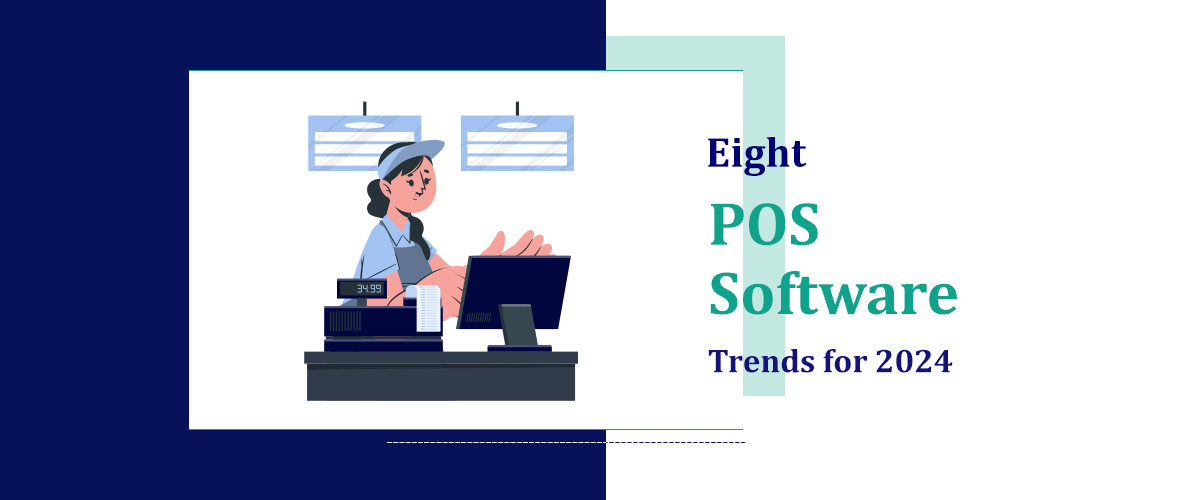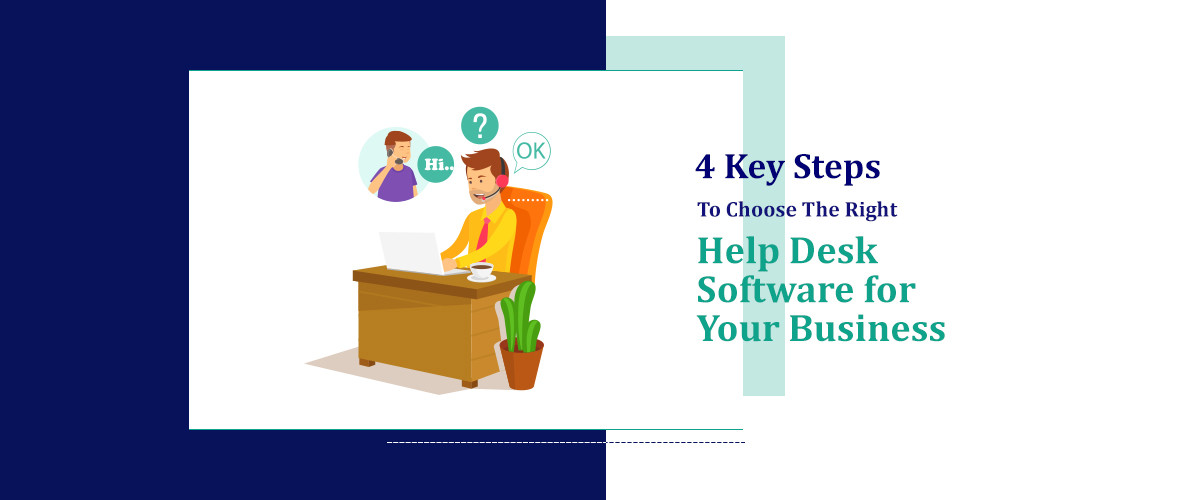What we'll cover
The retail industry is changing at a breakneck speed as contactless customer care becomes the new standard and data becomes king. The point of sale (POS) system has evolved from being a simple financial instrument to a hub for retail productivity, customer experience, and personalisation. It is essential for businesses to stay abreast of point-of-sale developments that have the potential to transform the retail experience, even as they prepare for the problems that come with every year. We will examine the top eight POS software USA developments that are expected to completely transform the retail industry this year in this in-depth report.
The Outlook of Retail POS Software in the Dawn of 2024
A retail transaction's heart and soul lies in its point of sale system (POS). However, it is more than that in a market where fierce online rivalry and complex in-store client needs are the norm—it is the core that distributes actionable data across a retail company. The themes that will be covered in this talk include the behavioural changes, technology advancements, and market factors that are transforming point-of-sale (POS) systems into tactical retail weapons.
A computerised system called point of sale (POS) software is made to make all the processes involved in a sales transaction easier and more efficient. In restaurants and retail establishments, it acts as the main hub for processing payments, keeping track of inventory, and managing sales. POS software provides a comprehensive solution that unifies sales data analysis, customer relationship management, and personnel administration into a one, seamless platform, going beyond just serving as a contemporary cash register. Businesses may run more effectively thanks to this technology, which offers real-time data about client preferences, inventory levels, and sales patterns.
Why is POS Software Important?
Businesses, particularly those operating in the US market, need Point of Sale (POS) software since it makes sales operations more effective and streamlined. It does more than just make financial transactions easier; it unifies sales reporting, customer relationship management, and inventory management onto one platform. With the real-time data insights this connection offers, organisations may better understand customer behaviour, intelligently manage inventory levels, and make well-informed decisions. This is incredibly helpful for restaurateurs and retailers to optimise operations, improve customer satisfaction, and eventually boost sales and profitability.
1. Hyper-personalization Through AI Integration
For a while now, retail has been all about personalisation, but putting it into practice has been difficult due to the intricacy of interpreting client data in real-time. A new era is being ushered in by POS systems with AI capabilities, where hyper-personalization is becoming the standard feature. These smart technologies have the ability to instantly create a highly customised shopping experience by analysing social media data, client preferences, and purchasing trends. Consider a point-of-sale system (POS) that identifies a valuable client as soon as they walk up to the counter and offers them recommendations right away based on their prior purchases and the social media influencers they follow.
2. Cloud-Based POS for Scalability and Mobility
The ecology of retail operations has changed due to cloud-based point-of-sale systems. Compared to conventional, on-premise systems, they provide never-before-seen scalability, mobility, and accessibility. Retail companies can now access real-time data from their point of sale (POS) on any device, manage several locations from one place, and never worry about out-of-date software. This trend not only lowers the hardware costs of traditional point-of-sale systems, but it also gives merchants the flexibility to dynamically adjust their POS software to meet changing client demands.
3. Blockchain for Transaction Security and Transparency
Though it is a relatively newcomer to the POS market, blockchain technology is making rapid progress. It provides unmatched business transactions and security, which is crucial for managing sensitive financial data. For shops, this translates to incredibly safe payment processing and an unquestionable audit trail that may boost consumer confidence and simplify compliance. To further streamline operations, blockchain's smart contract capabilities may also be able to automate loyalty programmes and reimbursements.
4. Integration of Multiple Payment Options
Convenience reigns supreme in today's financial environment. Retail point-of-sale (POS) systems are becoming increasingly flexible through their integration with various payment methods, such as bitcoin and mobile wallets. This pattern demonstrates how the retail industry is moving away from cash and how merchants who provide a wide range of easy-to-use payment choices are gaining the loyalty of their patrons. In addition to being payment processors, modern point-of-sale (POS) systems are multifunctional platforms that manage layaways, numerous bids, and cross-platform payment tracking.
5. Omnichannel Capabilities for a Unified Shopping Experience
A smooth transition between online and physical stores is known as omnichannel retail, and it is now required rather than optional. Leading this change are point-of-sale (POS) systems, which allow merchants to provide a cohesive purchasing experience.
'Buy online, pick up in store' (BOPIS), returns for online purchases made in-store, and even real-time inventory checks from the shop's point of sale are now advantages that customers may take advantage of. In addition to improving ease, this integration gives businesses a unified picture of consumer information and performance across all channels.
6. The Rise of Mobile POS and Self-Checkout
The way that consumers and businesses engage at the point of sale has drastically changed as a result of the widespread smartphone. Once considered unique, mobile point-of-sale (POS) and self-checkout technologies are becoming more and more common.
These technologies are becoming more and more popular, especially in industries where customers desire speedy, contactless transactions. In addition to cutting down on transaction costs and wait times, they also provide employees the freedom to go beyond conventional registers to deliver a more effective and individualised shopping experience.
7. Modular POS Systems for Customization and Future-Proofing
Systems that are modular in nature are replacing the POS models that are one-size-fits-all. Retailers may now choose the elements they require to create a customised, cost-effective solution that fits their business model. The ease with which new features may be added to these modular point-of-sale systems guarantees that shops have access to the newest resources to satisfy changing consumer demands.
Interoperability is also highly valued in this trend, which makes it possible for companies to easily combine their point-of-sale (POS) with marketing, inventory, and customer relationship management systems.
8. Sustainability and Eco-Friendly POS Solutions
Retailers are striving to implement point-of-sale (POS) systems that are not only eco-friendly but also efficient, in response to the growing worldwide awareness of environmental issues. This might involve anything from implementing software programmes that cut down on paper waste by means of digital receipts and real-time reporting to utilising point-of-sale hardware that is constructed from materials obtained sustainably.
The movement towards sustainability is not only a manifestation of corporate Barcode billing software USA; it is also turning into a differentiator for brands that may draw in an expanding consumer base.
Features Of POS Software
-
Real-time inventory management: Provides timely updates to avoid stockouts and overstocking by effectively monitoring and controlling stock levels across several sites.
-
Sales Reporting and Analytics: Produces comprehensive data on client preferences, purchasing trends, and sales performance to support strategic decision-making.
-
Employee management: Their software simplifies administrative duties by providing tools for scheduling, monitoring employee work hours, handling payroll, and more.
-
Customer Relationship Management (CRM): This system keeps track of preferences, past purchases, and customer data in order to improve customer interactions and tailor marketing campaigns.
-
Multi-Channel Integration: Provides a unified retail operation by seamlessly integrating with online marketplaces, e-commerce platforms, and other sales channels.
-
Payment processing: Provides a seamless Cheque printing software US experience by supporting a variety of payment options, such as gift cards, credit cards, and mobile payments.
-
Security and Compliance: Encryption, access restrictions, and adherence to payment industry standards are used to guarantee data security.
How To Choose The Right POS Software
-
Recognise Your Business Needs: Clearly identify your needs from a point of sale system before looking at other possibilities. Take into Auto dealer accounting software US your company's size, sector, and particular needs, such as client loyalty initiatives or inventory control.
-
Usability: Choose a POS system that is easy to use. It should be easy for your employees to use without requiring a lot of training, since this may cut down on errors and save time.
-
Capabilities for Integration: Verify whether the point-of-sale (POS) software can be integrated with other tools you use, such as customer relationship management (CRM) systems, e-commerce platforms, and accounting software. Integration may improve company management by streamlining processes and creating a more seamless experience.
-
Cost Analysis: Take into account all out-of-pocket expenses as well as any recurring charges for updates, support, and extra features. Make sure the price strategy fits your company's growth and budgetary expectations.
-
Security Features: To safeguard your data and the data of your clients, give top priority to point of sale systems that have robust security features. Seek for characteristics like industry standard compliance and end-to-end encryption.
-
Scalability: Select software that expands to meet the needs of your company. Without any major problems, it ought to be able to accommodate a rise in sales, a wider range of goods, and even the addition of more locations.
-
Customer Service: Providing excellent customer service is essential. Make sure the supplier has a solid track record of quickly resolving problems and provides thorough assistance across a variety of channels.
Conclusion
As we look towards 2024, the POS software market is undergoing a significant transformation driven by technological advancements and changing consumer demands. For businesses listed on SaaS Adviser, a leading software listing platform in the USA, staying abreast of these trends is crucial.
From the integration of AI and machine learning for personalised customer experiences to the adoption of cloud-based systems for better flexibility and scalability, each trend presents an opportunity for innovation and growth. Ensuring that POS systems are secure, user-friendly, and capable of providing actionable insights through analytics will be key for businesses aiming to thrive in an increasingly competitive landscape. By leveraging these trends, companies can not only enhance operational efficiency but also significantly improve customer satisfaction and loyalty.
Point of Sale (POS) software is a digital solution used by businesses to process transactions, manage inventory, and track sales in real-time at the point of purchase.
POS software trends highlight advancements and innovations in the industry, providing insights into new features, technologies, and strategies that can enhance business operations and customer experiences.
Common trends may include increased adoption of cloud-based POS systems, integration with emerging payment technologies, enhanced customer relationship management (CRM) features, improved data analytics capabilities, and more.
By staying informed about the latest POS software trends, businesses can identify opportunities to improve efficiency, streamline operations, boost sales, and stay competitive in an evolving market.
-
To implement POS software trends effectively, businesses should evaluate their current systems, assess their needs and goals, research available solutions, and choose a POS software provider that aligns with their objectives and budget.



